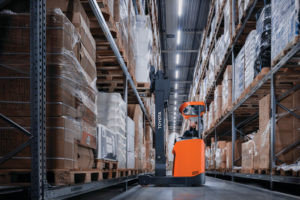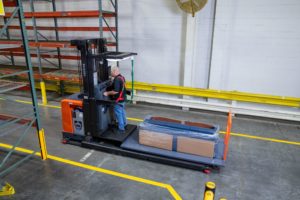Archive for January, 2022
Robotic Order Picking: Ask the Expert Series
In this part of our Ask the Expert Series, Toyota Material Handling Solutions’ Director of Sales and Marketing Anthony Spano answers frequently asked questions about robotic order picking.
Anthony helps companies find the ideal mix of automation, software, and labor to optimize productivity and deliver fast, accurate fulfillment to match the speed of modern commerce. His expertise has helped hundreds of companies in Los Angeles County maximize cube utilization, increase throughput, and increase their bottom line.
What is a robotic order picker?
A robotic order picking system is an automated storage and retrieval system (ASRS). It harnesses the power of warehouse robots for 24/7 order fulfillment within a cubic layout.
What are the benefits of order picking robots?
- Increased on-time delivery
- Reduced stock losses and errors
- Increased customer satisfaction
- Improved space utilization
- Lower building/rental and labor costs
Which order picking system do you recommend? 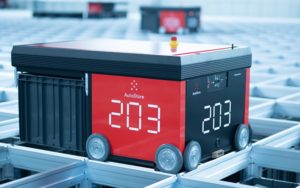
AutoStore is our system of choice.
What is AutoStore?
AutoStore is an innovative storage solution that allows complete customization and flexibility. In the AutoStore system, bins are stacked vertically in a grid and retrieved by robots that travel on the top layer of the system.
Does AutoStore work if you have a complicated warehouse layout?
Yes. Because AutoStore robots travel on the top layer of the system, the grid can exist around columns, on the mezzanine, and even on multiple levels.
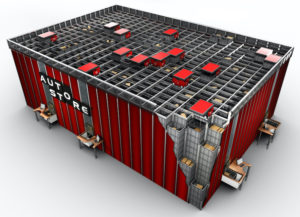 How does AutoStore work?
How does AutoStore work?
An AutoStore system contains four components: a structural grid, delivery robots, storage bins, and an operator port. Products live in bins within the dense aluminum grid. As a product is needed to fulfill an order, the system software and controls alert a robot to find the item’s bin.
How does the robot get to the bins on the bottom of the stack?
If the bin is beneath other bins, a robot stages the extra bins on top of the grid until it retrieves the desired container. It then takes that bin to the edge of the grid and delivers it to the operator fulfilling the order.
What happens to the bins on top of the grid after an order is retrieved?
As one robot delivers the bin, another AutoStore robot cleans up the staged bins on top of the grid by returning them to their original position.
Does the system get smarter with time?
Yes. As the order-picking process continues, the AutoStore system self-profiles. The bins with faster-moving products begin moving toward the top of the system, and bins with slower-moving products transition to the bottom.
How much space can you save with an AutoStore system?
In some cases, a company can increase storage capacity four-fold within the same footprint and unlock the true potential of storage floor space.
Is AutoStore a custom solution?
Yes, an AutoStore system is designed specifically for you. Each AutoStore is designed based on your operational needs, and we validate it through simulation backed by its control system.
Can I add AutoStore to my existing space?
Yes, AutoStore is easy to integrate into existing warehouses.
Can I use AutoStore if I have low ceilings?
Yes, AutoStore is fully customizable to fit any ceiling height.
What is the maximum lifting speed of an AutoStore robotic order picker?
An AutoStore robot has a maximum lifting speed of 5.2 feet per second.
What industries use AutoStore systems?
You can find AutoStore systems in grocery, retail, healthcare, e-commerce warehouses, third-party logistics centers, parts management facilities, and many other specialty industries.
Do you have any case studies to share?
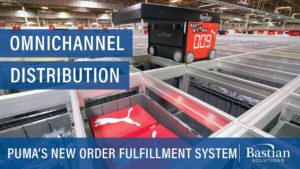
Yes. We partner with Bastian Solutions, a Toyota Logistics company and a global AutoStore integrator. Click here to learn how they modernized Best Buy’s supply chain with advanced automation. You can also watch how they helped Puma increase capacity tenfold and boost productivity by twenty percent at their facility in Indianapolis.
Is 2022 the year you add robots and automation to your order picking process? Don’t tackle it alone. Let our experts with decades of experience help take your warehouse or distribution center to the next level. Contact us to get started today!
Ask the Expert Series: Robotic Palletizing
In this blog post, Toyota Material Handling Solutions’ Director of Sales and Marketing Anthony Spano answers frequently asked questions about robotic palletizing systems and solutions.
Anthony has a decade of expertise in maximizing cube utilization and increasing throughput by employing the ideal mix of automation, software, and labor. His superpower is using high-performance solutions to help companies optimize productivity and deliver fast, accurate fulfillment to match the speed of modern commerce.
What is a robotic case palletizer?
A robotic palletizer employs a robotic arm to pick, orient, and place individual products and arrange them into a single stack or load.
What are the benefits of a robotic palletizing solution?
There are numerous benefits of using a palletizing robot, but I will stick to the top five.
- Increased productivity: Palletizers eliminate manual labor for unitizing products. They are much more efficient, lift heavier loads, and perform faster.
- Better product handling: Since palletizers are automated machines, their movements are pre-programmed to function without damaging the product.
- Small and flexible: Palletizing robots typically have a smaller footprint than other solutions, offer greater flexibility, and fit in extremely tight spaces.
- Improved workplace safety: Robotic palletizers eliminate many workplace hazards typically associated with manual labor like falling, tripping, and muscle strains from repetitive actions.
- Reduced operating costs: Most operations can save money by increased productivity, low product damage, and reduced labor costs.
How does a robotic case palletizer work?
A palletizing robot picks one or multiple cases from a conveyor system and places them on a pallet. The process continues layer by layer until the pallet is complete.
How does the palletizing robot know what to pick and place?
Pallet patterns, which can easily be changed or added, are programmed into the palletizing robot.
What is the function of an end-of-arm tool? 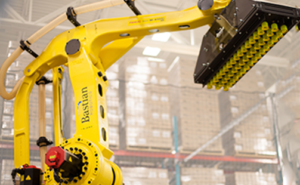
The end of arm tool can handle multiple types of containers simultaneously, regardless of their shape. It can pick up cases, bags, pails, bottles, batteries, cubes of scrap metal, plastic containers, and many other things.
Can a robotic palletizing solution handle different patterns and product types?
Yes. A robotic palletizer can handle one or more units according to pallet configuration and forms multiple layers on a pallet after picking the products off a conveyor.
Can a palletizing robot handle multiple feeds of different SKUs on the same line?
Yes. There are systems to send information to the robot to pick and place different SKUs on different pallets.
How much weight can a palletizing robot handle?
Robotic palletizing systems can typically handle up to 2,200 pounds.
How fast are palletizing robots?
For a single robot picking a single product, palletizing rates can vary anywhere from eight to thirty cases a minute, depending on stacking patterns and other requirements.
How long can a palletizing robot operate?
Unlike human labor, palletizing robots do not experience exhaustion or injuries. With proper maintenance, palletizers can reliably operate 24/7.
Can a robotic palletizing system and solution serve multiple lines?
Yes. One robotic palletizer can work between two or more packaging lines.
Can a palletizing robot perform secondary tasks?
Yes, some robotic palletizers have a vacuum, magnetic, or custom end-of-arm tools to give them the ability to perform additional tasks such as slip sheet dispensing, pallet placing, and wrapping.
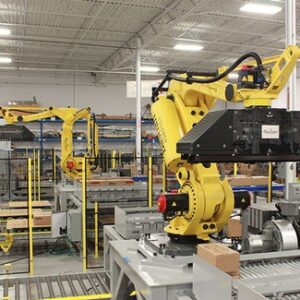 Can a robotic palletizing system reverse its operation?
Can a robotic palletizing system reverse its operation?
Yes. This feature is on robotic palletizers-depalletizers.
What industries typically use robotic case palletizers?
You can find palletizing robots in many industries, including food and beverage, life sciences, packaged goods, electronics, and more.
Are there pictures and videos available?
Yes, click here for pictures and videos of robotic palletizers in action.
Do you have other automated warehouse solutions?
Yes. Click here for tips on how to upgrade your warehouse for maximum efficiency.
Implementing a robotic palletizing system requires knowledge and planning. Let our team of storage and automation experts design a unique plan just for you.
If you are in Los Angeles County, contact us for a free consultation today.

